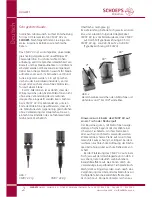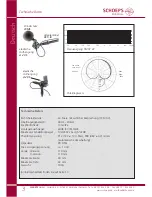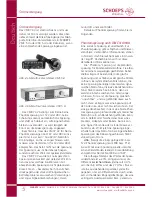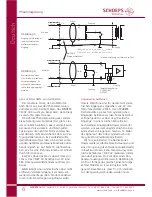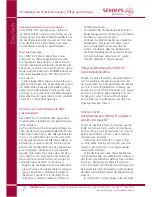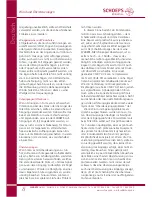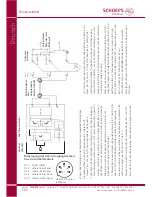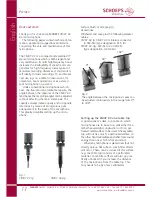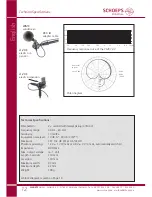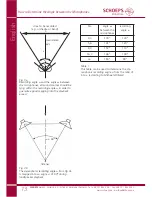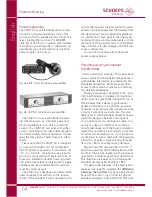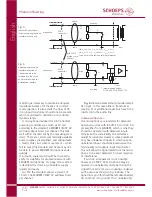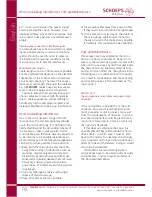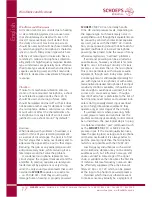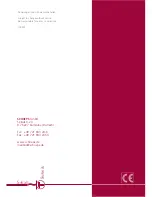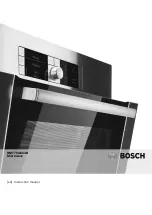
act” must occur between the power supply
and the preamplifier input, however, since
naturally all three pins of the microphone must
still connect to its phantom or parallel power
supply.
Simultaneous Connection to Multiple Inputs
If a microphone has to be connected to multiple
inputs simultaneously, an active micro phone
splitter should be used in order to preserve
the loading and powering conditions for the
microphone, and to prevent interference.
Maximum Cable Length
Cable lengths of up to 300 meters are possible,
but the practical limit depends on the electrical
capacitance of the cable, which is sometimes
an unknown quantity. The lower this capaci-
tance is per unit length, the longer the cable can
be. All
SCHOEPS
cables have very low capaci-
tance (100 pF/m between the conductors).
The main risks with excessively long micro-
phone cables are losses at high frequencies
due to cable capacitance, reduced ability to
handle very high sound pressure levels, and
increased likelihood of picking up interference.
Hints on Avoiding Interference
Due to the wide dynamic range of studio
microphones, the smallest signal amplitudes
are in the microvolt range (1/1,000,000 Volt).
Cable shielding and the grounding scheme of
the preamp or mixer input are also crucial.
A microphone can therefore never be expected
to be immune to all possible disturbances in
all circumstances, but the following suggestions
can help to reduce possible noise induction:
1) Keep both the microphone and the cable
away from sources of interference such as
monitors, digital equipment (computers),
RF emitters (mobile phones and other per-
sonal communication devices that emit radio
frequency energy), power transformers,
power lines, SCR dimmers, switching power
supplies etc.
2) Use only high-quality cables with a high
degree of shield coverage.
3) Keep all cables as short as possible.
4) Dress audio cables away from power cables.
If they must cross, it should be at right angles.
5) At the preamp or mixer input, the shield of
the microphone cable should connect to
chassis ground in the shortest way possible.
If necessary, this coupling can be capacitive.
Care and Maintenance
Please take care to avoid placing the micro-
phone in a dusty environment. Keep it in its
case (e.g. the wood carrying case it comes with)
when not in use, since any dust that gets inside
the microphone can adversely affect its func-
tioning. Dust can affect the microphone in the
following way: In combination with humid ity
it can lead to condensation and thus popping
and crackling noises (often described as ”fry-
ing sounds”).
What to do if …
the microphone is noisy (clicks and pops) in high
humidity?
If the microphone is brought from the cold
outdoors into a warm (and humid) environ-
ment, snapping or clicking noises can result
from the condensation of moisture. In such a
case the microphone should be given time to
reach room temperature, and as a rule it will
then perform flawlessly.
If this does not eliminate the noise, it is
possible that dirt has gotten inside the micro-
phone itself – in which case it must be sent
back to the factory for cleaning. We strongly
urge customers not to open the microphone or
attempt to clean it themselves. Doing so would
also void all warrantees.
Windscreens are recommended when
micro phones have to be used in dirty or dusty
environments in order to avoid problems of
the kind described above.
SCHOEPS
GmbH · Spitalstr. 20 · D-76227 Karlsruhe (Durlach) · Tel: +49 721 943 20-0 · Fax: +49 721 943 2050
www.schoeps.de · [email protected]
Hints on Avoiding Interference / Care and Maintenance
16
English

